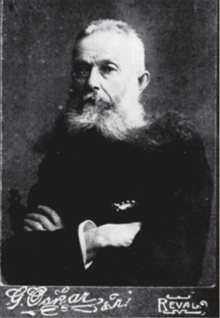Nikolai von Glehn
Alexander Nikolai von Glehn ( Russian Александр Николай фон Глен * July 16 jul. / 28. July 1841 greg. In the village Jälgimäe in Saku (Estonia) ; † 7. September 1923 in Ouro Fino in Minas Gerais ) was a Baltic German landowner and Architect .
Life
Nikolai von Glehn was the son of the landlord Peter von Glehn (1796–1843), who had bought the Jälgimäe estate in 1821, and his wife Auguste Caroline Marie nee. Burchart von Bellavary (1814–1862), who ran the Tallinn council pharmacy . His older brother Peter von Glehn (1835–1876) was an explorer and botanist .
Nikolai von Glehn studied economics , medicine , philosophy and architecture at the University of Dorpat and in Germany .
Glehn married Caroline Henriette Berg (1847-1896) in 1866. He managed his father's inheritance in the south of Reval and founded the village of Nõmme for the construction of dachas in 1878 at a stop on the railway line from Reval to Paldiski built in 1872 in the north of his lands . He also designed and built his Hohenhaupt estate , which immediately became known as Glehns Burg . The main building, the castle, was completed in 1886 and was surrounded by a park with a palm house (1900-1910), an observatory (1910, now Tallinn Observatory ), a miniature castle for his children and Glehn's sculptures Kalevipoeg and Crocodile (1908). As an architect, he has been compared to Antoni Gaudí . After his wife's death, he had Glehn's cemetery laid out for her , where two of his son Manfred's children who died early were buried.
After the October Revolution , Glehn emigrated to Germany in 1918 and to Brazil in 1922 when his son Manfred von Glehn (1867–1924) needed healing treatment in a warm climate.
On November 12, 2011, Glehn received a memorial on a pedestrian bridge in the center of Nõmme.
Works
literature
- Anna-Kristiina Einama: Nikolai von Glehn loovisikuna (Estonian, accessed January 15, 2016).
- Anneli Tuulik, Lilian Kaseväli, Erki Korp: Peter von Glehn - ühe paruni lugu . Viljandi: Print Best, 2013, 328 pp. ISBN 9789949333257 (Estonian).
- Carola L. Gottzmann , Petra Hörner: Lexicon of the German-language literature of the Baltic States and St. Petersburg . De Gruyter, Berlin 2007, ISBN 978-3-11-019338-1 , p. 475 f .
Individual evidence
| personal data | |
|---|---|
| SURNAME | Glehn, Nikolai von |
| ALTERNATIVE NAMES | Glehn, Alexander Nikolai von (full name); Глен, Александр Николай фон (Russian) |
| BRIEF DESCRIPTION | Baltic German squire and architect |
| DATE OF BIRTH | July 28, 1841 |
| PLACE OF BIRTH | Saku (Estonia) |
| DATE OF DEATH | September 7, 1923 |
| Place of death | Ouro Fino, Minas Gerais |





